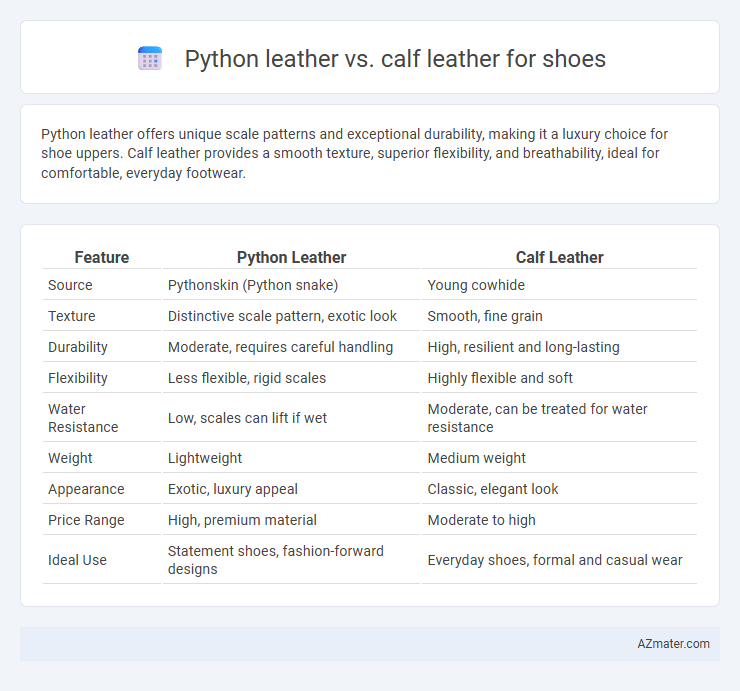Python leather offers unique scale patterns and exceptional durability, making it a luxury choice for shoe uppers. Calf leather provides a smooth texture, superior flexibility, and breathability, ideal for comfortable, everyday footwear.
Table of Comparison
| Feature | Python Leather | Calf Leather |
|---|---|---|
| Source | Pythonskin (Python snake) | Young cowhide |
| Texture | Distinctive scale pattern, exotic look | Smooth, fine grain |
| Durability | Moderate, requires careful handling | High, resilient and long-lasting |
| Flexibility | Less flexible, rigid scales | Highly flexible and soft |
| Water Resistance | Low, scales can lift if wet | Moderate, can be treated for water resistance |
| Weight | Lightweight | Medium weight |
| Appearance | Exotic, luxury appeal | Classic, elegant look |
| Price Range | High, premium material | Moderate to high |
| Ideal Use | Statement shoes, fashion-forward designs | Everyday shoes, formal and casual wear |
Introduction to Python and Calf Leather
Python leather, sourced from the skin of pythons, offers a unique scale pattern and high durability, making it a premium choice for luxury shoes that require exotic aesthetics. Calf leather, derived from young cows, is prized for its smooth texture, suppleness, and fine grain, providing exceptional comfort and breathability in footwear. Both leathers are favored in shoe manufacturing, with python leather emphasizing distinctive style and calf leather delivering classic elegance and longevity.
Origin and Sourcing of Python and Calf Leather
Python leather is sourced primarily from Southeast Asia, notably Thailand and Indonesia, where the reticulated python is native and skins are harvested through regulated wildlife trade and farming practices. Calf leather originates from young cattle raised in regions such as Europe, North America, and Australia, with sourcing heavily dependent on the livestock industry and strict animal welfare standards. The origin of each leather type influences the texture, durability, and ethical considerations in shoe manufacturing, with python featuring exotic scales and calf leather offering a smooth, uniform grain.
Texture and Appearance Comparison
Python leather exhibits a distinctive, highly textured surface characterized by irregular, raised scales that create a bold, exotic appearance ideal for statement shoes. Calf leather features a smooth, fine grain with a consistent texture, offering a more refined and classic look suitable for formal footwear. While python leather provides a unique, tactile experience, calf leather is prized for its supple softness and polished finish, making each material optimal for different aesthetic and tactile preferences in shoe design.
Durability and Longevity
Python leather, known for its distinctive scale pattern, offers moderate durability but requires careful maintenance to prevent drying and cracking. Calf leather is highly durable and ages gracefully, developing a patina that enhances both its appearance and longevity over time. For shoe longevity, calf leather generally outperforms python leather as it withstands daily wear and environmental factors more effectively.
Comfort and Wearability
Python leather offers a distinctive texture and flexibility, making it highly breathable and adaptable to foot shape over time, which enhances comfort during prolonged wear. Calf leather is known for its soft, smooth surface and durability, providing excellent cushioning and long-lasting support, making it ideal for all-day use. Both materials contribute to wearability, but calf leather generally offers better resilience against wear and maintains comfort with consistent use.
Maintenance and Care Requirements
Python leather demands careful maintenance due to its delicate scales that can lift or crack if exposed to excessive moisture or harsh cleaning agents, requiring the use of specialized brushes and conditioners designed for exotic skins. Calf leather offers more durability with a smoother surface, allowing for easier cleaning with standard leather care products and regular polishing to maintain its supple texture and prevent drying. Both types benefit from avoiding prolonged exposure to direct sunlight and storing shoes in breathable conditions to preserve their appearance and longevity.
Environmental and Ethical Considerations
Python leather production often involves the killing of wild snakes, raising concerns about biodiversity loss and habitat disruption, whereas calf leather generally comes from domesticated cattle with more regulated farming practices. The tanning process for both leathers typically uses harmful chemicals, but calf leather benefits from more established environmental regulations and sustainable initiatives in cattle farming. Ethical considerations for python leather include the impact on wild populations and illegal poaching risks, while calf leather's ethics focus on animal welfare standards and the carbon footprint of livestock farming.
Pricing and Market Value
Python leather commands a higher price in the luxury shoe market due to its exotic status, unique scale patterns, and rarity compared to calf leather. Calf leather is more widely available and affordable, offering durability and a softer texture, making it a common choice for premium but more accessible footwear. Market value for python leather shoes is significantly influenced by exclusivity and fashion trends, often resulting in higher resale prices than calf leather counterparts.
Popular Shoe Designs and Brands
Python leather is prized in luxury shoe designs for its distinctive scale pattern and exotic appeal, often featured in high-end brands like Christian Louboutin and Gucci, enhancing statement footwear such as boots and loafers. Calf leather offers smooth, supple texture favored by brands like Allen Edmonds and Tod's, commonly used for classic dress shoes and versatile sneakers due to its durability and refined appearance. Both materials influence popular shoe aesthetics, with python leather catering to bold, fashion-forward styles, while calf leather supports timeless, elegant designs.
Choosing the Right Leather for Your Shoes
Python leather offers a distinctive texture and durability, making it ideal for high-fashion shoes that demand a unique aesthetic and long-lasting wear. Calf leather provides a smoother, more supple feel with excellent breathability, perfect for everyday shoes requiring comfort and flexibility. Selecting the right leather depends on balancing style preferences with practical needs such as durability, comfort, and the occasion for which the shoes will be worn.

Infographic: Python leather vs Calf leather for Shoe
 azmater.com
azmater.com